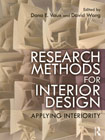
Research Methods for Interior Design: Applying Interiority
Vaux, Dana E.
Wang, David
Interior design has shifted significantly in the past fifty years from a focus on home decoration within family and consumer sciences to a focus on the impact of health and safety within the interior environment. This shift has called for a deeper focus in evidence-based research for interior design education and practice.? Research Methods for Interior Design provides a broad range of qualitative and quantitative examples, each highlighted as a case of interior design research. Each chapter is supplemented with an in-depth introduction, additional questions, suggested exercises, and additional research references. The book’s subtitle, Applying Interiority, identifies one reason why the field of interior design is expanding, namely, all people wish to achieve a subjective sense of well-being within built environments, even when those environments are not defined by walls. The chapters of this book exemplify different ways to comprehend interiority through clearly defined research methodologies. This book is a significant resource for interior design students, educators, and researchers in providing them with an expanded vision of what interior design research can encompass. Table of Contents Introduction Dana E. Vaux and David Wang Chapter 1 Focus Groups Introduction Interiority at the Scale of Neighborhoods: Exploring the health experiences of three cultural groups Tasoulla Hadjiyanni Discussion and Exercises Chapter 2 Design ethnography Introduction Understanding User Experience within Flexible Workplaces: An Ethnographic Approach Isil Oygur, Ozgur Gocer and Ebru Ergoz Karahan Discussion and Exercises Chapter 3 Narrative inquiry Introduction Narratives of Healing: The Records of the Visiting Nurse Service of New York in the Era of the Great Depression Erin Cunningham Discussion and Exercises Chapter 4 Applied historic preservation: Introduction A Local Meeting Place: The Adaptive Reuse of the Huffman House Lisa Tucker Discussion and Exercises Chapter 5 Oral histories Introduction Living and Moving, Thingly (Interior) History Bryan D. Orthel Discussion and Exercises Chapter 6 Philosophical method Introduction Interior Design in the Common Sense David Wang Discussion and Exercises Chapter 7 Logical argumentation Introduction Understanding Place Meaning through Ethos Intensive Objects Dana E. Vaux Discussion and Exercises Chapter 8 Mixed methods Introduction Validating ‘feeling at home’: Developing a Psychological Construct Pattern to aid in the Design of Environments for the Homeless Jill Pable Discussion and Exercises Chapter 9 Correlation Introduction Correlating Interior Lighting with Teacher Productivity Levels in the Public preK-12 Classroom Alana Pulay Discussion and Exercises Chapter 10 Scale Creation Introduction Measuring the "Thirdplaceness" of Social Media Platform Michael R. Langlais and Dana E. Vaux Discussion and Exercises Chapter 11 Virtual simulation Introduction Biometric Data and Virtual Response Testing in a Classroom Design Saleh Kalantari Discussion and Exercises Chapter 12 Creative scholarship Introduction Computational design: organic growth and research tactics. Interview with Andrew Kudless by David Wang and Dana E. Vaux Discussion and Exercises Index
- ISBN: 9780367139490
- Editorial: ROUTLEDGE LTD.
- Encuadernacion: Rústica
- Páginas: 264
- Fecha Publicación: 29/07/2020
- Nº Volúmenes: 1
- Idioma:
